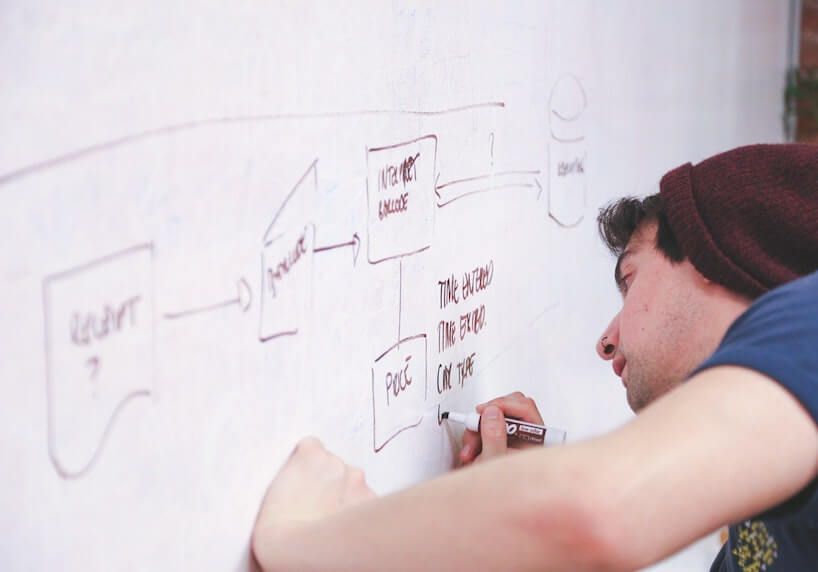Why design thinking promotes innovation
Anyone dealing with IT, Digitization or artificial intelligence, sooner or later comes across the term Design Thinking. This method can be used to set creative processes in motion. The goal: to promote innovation. But what is behind it? How does design thinking work when it comes to IT?
We consider creative thinking to be an indispensable prerequisite for developing new things. Creativity is the key to innovations, new products and solutions. Ideally, new developments are based on the needs of the users. The “Design Thinking” method is a useful development tool for this.
Everyone can be creative

The innovation method was originally developed by David Kelley. He is the founder of the Ideo design agency in Silicon Valley. Professors Terry Winograd and Larry Leifer from the “d.school” at Stanford University played a key role in shaping the approach. It is therefore only logical that those interested read this quote on the university’s homepage:
“We believe that everyone has the capacity to be creative.”
The focus is on the customer
Since the method comes from the field of design, the focus is on the customer and their needs. Designers traditionally work in a user-oriented manner. They often provide ideas for new products. It’s the same in segments like IT.
Design Thinking uses this. Design Thinkers use this method to analyze the needs of customers or potential customers. In IT, for example, this can be the optimization of a workflow with the help of intelligent software.
Teamwork promotes thought processes
But how is that now with creativity and innovations? Do they flow at the push of a button? No. But innovations can be planned. That sounds surprising. However, creative processes are all about working out solutions in short, creative team work phases. This means that the development process is characterized by mutual respect and trust.
This also includes having the courage to fail. As well as an open and constructive feedback culture. The change of perspective in different teams also allows ideas to mature. A creative environment can also provide decisive impulses.
Design Thinking Phasen
The design thinking process is divided into six phases, which are divided under the terms orientation and have the solution summarized.
Orientation
1. Phase: Understanding
This initial phase is about understanding the project and getting involved with the team members. Everyone has a different point of view and way of thinking. Discuss the aspects of the project. Is there a holistic approach in the team? Gather the information. Whiteboards, mind maps and post-its are ideal for this.
2. Phase: Observe
This phase serves to build empathy: to empathize with customers and their needs, to understand their problems and wishes. Those who observe, learn a lot of new things and get to know their counterparts. It is important to put your own point of view aside. It is important to get involved with the customer, to focus. Furthermore, it is also important to reflect on the observations.
3. Phase: Define perspective
Now it is even more concrete than in the previous phases. The really important and possibly still undiscovered needs of customers are explored. It becomes clear from which different perspectives the participants define the problem.
For example, if the aim is to optimize work processes for a customer, a new software solution may be necessary. Each participant in the design thinking process sets different priorities. Some consider the cost aspect to be important, others focus on employee training, implementation period, cost amortization or the corporate structure.
So-called empathy cards or persona templates can be used to structure the customer in question help. With these, the team members determine what the person thinks, feels, does or says. The template clarifies questions such as: What does the persona do during the day? What is important to her? What needs does she have?
Solution
4. Phase: Generate ideas
In the last three phases of the design thinking process, the team members concentrate on finding solutions, prototyping and testing. The aim in the fourth step is to develop as many ideas as possible. Possible solutions can be developed with different methods of generating ideas.
This can be classic brainstorming, in which all ideas are placed, as well as a change of perspective, for example by looking into the future. But also negative brainstorming – here all ideas are collected that do not solve the problem, can be a way to come up with ideas.
5. Phase: Develop prototypes
Some participants are now starting to tinker: paper planes or similar creations should encourage people to move from theory to practice. The prototype is developed. The idea developed in the previous phase emerges in concrete terms.
So concrete that the user, i.e. the persona, can test it in the last phase. For this, tangible prototypes are created with which the user can interact. For IT, this means that the solution is implemented properly for the first time. It is logical that not all of the details have been implemented at this stage. The first thing to do is to determine whether the solution is the right one. The forms of representation of the prototype range from mock-ups and wireframes to storyboards, videos or structured descriptions of services.
6. Phase: Testing
Now it is important to test whether the solution approach fits, meets the needs of the user. After all, the prototype was created from the team’s considerations as to which IT solution might be the right one for the customer.

That means looking for test subjects. In the test phase, you should be able to give feedback as unaffected as possible. Now there is no place for sales calls. It is much more important to find out what is good, where should be readjusted and which functions may still be missing. It is important to listen carefully to the customer, to let him speak.
Iteration – Repeat
In IT, iteration means repetition. In the design thinking process, the term describes that the team looks back one or more steps. For example on the persona definition. Has it been defined for the customer or does it have to be readjusted? This is why the early communication with the customer is so important. As well as documenting the individual steps and, above all, the feedback. This allows deviations to be tracked quickly. But also how and why an idea was developed.





